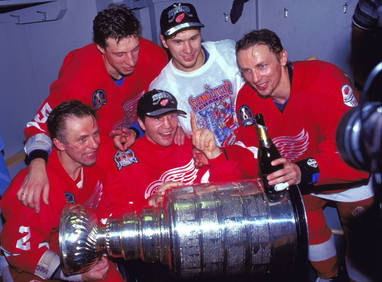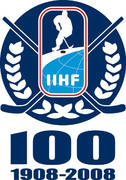

Story #79 Scotty Bowman forms NHL's first-ever "Russian five"1996-98, Detroit Red Wings One of the most important results of the Summit Series of 1972 was a recognition by Canada and the Soviet Union that each nation had a distinct style of play, and in ensuing years each took styles from the other and incorporated them into their own game. For instance, Canada learned about puck movement while the Soviets learned about physical play. But there were other subtle examples, one of which was the Soviets' penchant for uniting their forward line and defence pairing into a cohesive five-man unit. It wasn't until a quarter of a century later, however, that this strategy was used in the NHL, and the distinction of making a successful go of it belongs to Detroit Red Wings coach Scotty Bowman.
When Bowman started coaching Detroit in 1993, he inherited a roster that quickly became among the top teams in the league. The team made it to the Stanley Cup finals in 1996, but the Wings were quickly dispatched by the Colorado Avalanche in four straight games. No matter. Bowman's team returned to the finals the next year, and this time it was the Wings who did the sweeping, of Philadelphia, in four straight games.
A large part of Detroit's success came from the Russian fivesome of defencemen Vyacheslav Fetisov and Vladimir Konstantinov and forwards Igor Larionov, Sergei Fedorov, and Slava Kozlov. The uniting of these five was inspired, to say the least. Bowman had two veterans in Fetisov and Larionov who were revered by the next generation of players, among whom the other three were the cream of the crop. Not only had all the players grown up under the Soviet system of hockey, the younger players were inspired by and motivated by their elders, and the veterans in turn acted as de facto coaches for their Soviet protégés.
The result was a Stanley Cup which was of historic significance as the wily Bowman took a page from the old Soviet playbook and used it in a modern way with a combination of old school and new school players. The political meaning of the coaching strategy was almost as important as the hockey results. Had Bowman used a five-man unit in 1972, he might have been branded a traitor. In 1997, he was called a genius.
 About the Top 100 StoriesAs part of the IIHF's 100th anniversary celebrations, www.IIHF.com is featuring the 100 top international hockey stories from the past century (1908-2008). Starting now and continuing through the 2008 IIHF World Championships in Canada, we will bring you approximately three stories a week counting down from Number 100 to Number 11.
The Final Top 10 Countdown will be one of the highlights of the IIHF's Centennial Gala Evening in Quebec City on May 17, the day prior to the Gold Medal Game of the 2008 World Championship.
These are the criteria for inclusion on this list: First, the story has to have had a considerable influence on international hockey. Second, it has to have had either a major immediate impact or a long-lasting significance on the game. Third, although it doesn't necessarily have to be about top players, the story does have to pertain to the highest level of play, notably Olympics, World Championships, and the like. The story can be about a single moment — a goal, a great save, a referee's call — or about an historic event of longer duration — a game, series, tournament, or rule change. |
 Click here for the 100 Top Stories
|
|






